North Korea launches intercontinental missile, spiking tensions
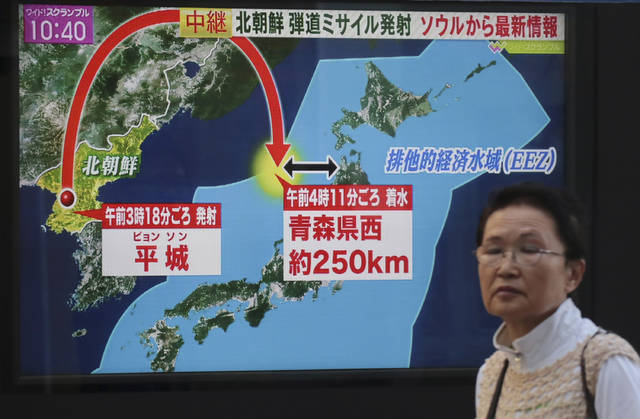
A woman walks past a TV screen broadcasting news of North Korea’s missile launch, in Tokyo, Wednesday, Nov. 29, 2017. After 2 ½ months of relative peace, North Korea launched its most powerful weapon yet early Wednesday, a presumed intercontinental ballistic missile that could put Washington and the entire eastern U.S. seaboard within range. The letters on top read ” Live. North Korean ballistic missile launch. The latest information from Seoul.” (AP Photo/Shizuo Kambayashi)
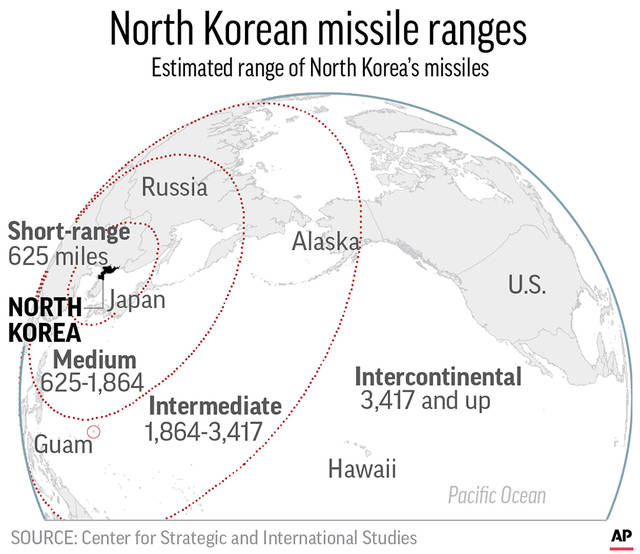
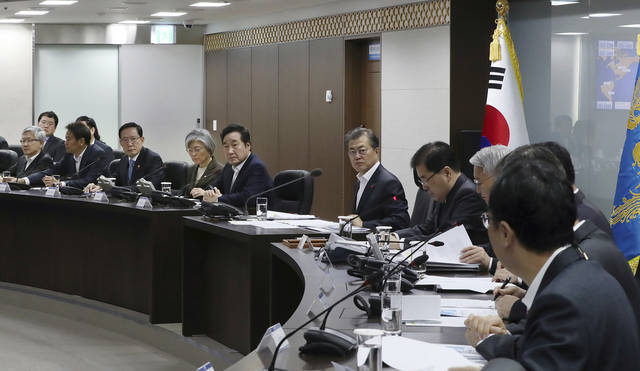


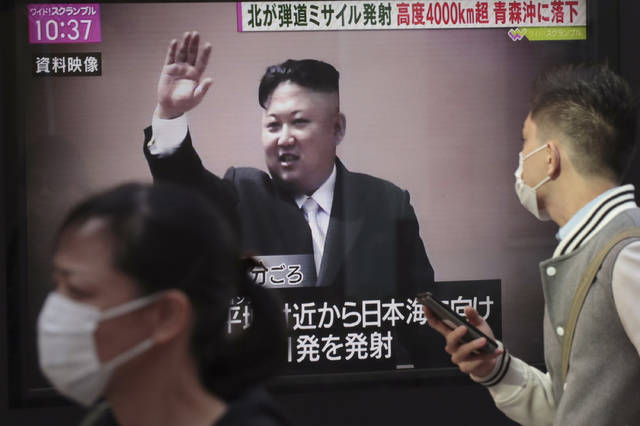
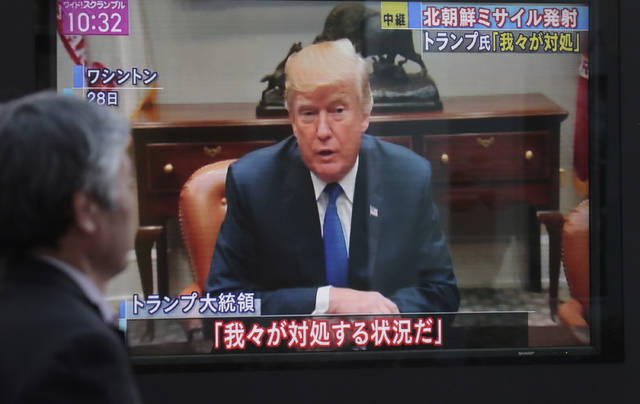
SEOUL, South Korea — After 2 ½ months of relative peace, North Korea launched its most powerful weapon yet early Wednesday, claiming a new type of intercontinental ballistic missile that some observers believe could put Washington and the entire eastern U.S. seaboard within range.
SEOUL, South Korea — After 2 ½ months of relative peace, North Korea launched its most powerful weapon yet early Wednesday, claiming a new type of intercontinental ballistic missile that some observers believe could put Washington and the entire eastern U.S. seaboard within range.
The North said in a special televised announcement hours after the launch that it had successfully fired what it called the Hwasong-15, a new nuclear-capable ICBM that’s “significantly more” powerful than the long-range weapons it’s previously tested. Outside governments and analysts backed up the North’s claim to a jump in missile capability.
A resumption of Pyongyang’s torrid testing pace in pursuit of its goal of a viable arsenal of nuclear-tipped missiles that can hit the U.S. mainland had been widely expected, but the apparent power and suddenness of the new test still jolted the Korean Peninsula and Washington. The launch at 3:17 a.m. local time and midday in Washington indicated an effort to perfect the element of surprise and to obtain maximum attention in the United States.
In a government statement released through state media, North Korea said the Hwasong-15, the “greatest ICBM,” could be armed with a “super-large heavy nuclear warhead” and striking the “whole mainland” of the United States. The North said the missile, which was fired near the capital Pyongyang, reached a maximum height of 2,780 miles and traveled 590 miles before accurately hitting a sea target, similar to the flight data announced by South Korea’s military.
The North said the missile, which was fired at the “highest” launch angle, didn’t pose a security threat to its neighbors. It said leader Kim Jong Un after the successful launch “declared with pride” that the country has achieved its goal of becoming a “rocket power.”
“The development and advancement of the strategic weapon of the DPRK are to defend the sovereignty and territorial integrity of the country from the U.S. imperialists’ nuclear blackmail policy and nuclear threat, and to ensure the peaceful life of the people, and therefore, they would not pose any threat to any country and region as long as the interests of the DPRK are not infringed upon,” said the statement, referring to North Korea’s official name, the Democratic People’s Republic of Korea.
The firing is a clear message of defiance aimed at the Trump administration, which had just restored the North to a U.S. list of terror sponsors. It also ruins nascent diplomatic efforts, raises fears of war or a pre-emptive U.S. strike and casts a deeper shadow over the security of the Winter Olympics early next year in South Korea.
A rattled Seoul responded by almost immediately launching three of its own missiles in a show of force. The South’s president, Moon Jae-in, expressed worry that North Korea’s growing missile threat could force the United States to attack the North before it masters a nuclear-tipped long-range missile, something experts say may be imminent.
“If North Korea completes a ballistic missile that could reach from one continent to another, the situation can spiral out of control,” Moon said at an emergency meeting in Seoul, according to his office. “We must stop a situation where North Korea miscalculates and threatens us with nuclear weapons or where the United States considers a pre-emptive strike.”
Moon, a liberal who has been forced into a more hawkish stance by a stream of North Korean weapons tests, has repeatedly declared that there can be no U.S. attack on the North without Seoul’s approval, but many here worry that Washington may act without South Korean input.
The launch is North Korea’s first since it fired an intermediate-range missile over Japan on Sept. 15, and may have broken any efforts at diplomacy meant to end the North’s nuclear ambitions. U.S. officials have sporadically floated the idea of direct talks with North Korea if it maintained restraint.
The missile also appears to improve on North Korea’s past launches.
If flown on a standard trajectory, instead of Wednesday’s lofted angle, the missile would have a range of more than 8,100 miles, said U.S. scientist David Wright, a physicist who closely tracks North Korea’s missile and nuclear programs.
“Such a missile would have more than enough range to reach Washington, D.C., and in fact any part of the continental United States,” Wright wrote in a blog post for the Union for Concerned Scientists.
North Korea’s description of a “super-large heavy” warhead is also likely to raise debate on whether the country is planning another nuclear test to demonstrate it has such a weapon. When the North flight tested two of its older ICBM models, the Hwasong-14s, in July, it said the missiles were capable of delivering “large-sized heavy” warheads. The North went on to conduct its sixth and most powerful nuclear test on Sept. 3, which it described as a detonation of a weapon built for ICBMs.
South Korea’s National Intelligence Service told lawmakers in a closed-door briefing on Wednesday that the possibility of another North Korean nuclear test “cannot be discounted,” lawmaker Kim Byung-kee said.
Japanese Defense Minister Itsunori Onodera said the missile landed inside of Japan’s special economic zone in the Sea of Japan, about 155 miles west of Aomori, which is on the northern part of Japan’s main island of Honshu.
A big unknown, however, is the missile’s payload. If, as expected, it carried a light mock warhead, then its effective range would have been shorter, analysts said.
Hawaii, at a distance of 4,660 miles from North Korea, is much closer. A missile would arrive in 20 minutes.
An intercontinental ballistic missile test is considered particularly provocative, and indications that it flew higher than past launches suggest progress by Pyongyang in developing a weapon of mass destruction that could strike the U.S. mainland. President Donald Trump has vowed to prevent North Korea from having that capability — using military force if necessary.
In response to the launch, Trump said the United States will “take care of it.” He told reporters after the launch: “It is a situation that we will handle.” He did not elaborate.
Pentagon spokesman Col. Rob Manning said the missile was launched from Sain Ni, North Korea, and traveled about 1,000 kilometers (620 miles) before landing in the Sea of Japan within 370 nautical kilometers (200 nautical miles) of Japan’s coast. It flew for 53 minutes, Japan’s defense minister said.
South Korea’s responding missile tests included one with a 1,000-kilometer (620-mile) range, to mimic striking the North Korea launch site, which is not far from the North Korean capital.
The U.N. Security Council scheduled an emergency meeting for today at the request of Japan, the U.S. and South Korea.
Italy’s U.N. Ambassador Sebastiano Cardi, the current Security Council president, told reporters late Tuesday that “it’s certainly very worrying. Everybody was hoping that there would be restraint from the regime.”
He said the latest and toughest sanctions resolutions against North Korea “are working, having an effect on the situation … on the capacity of the regime to obtain hard currency because to go along with the military programs or missile or nuclear (programs) you need money, and that’s the objective.”
“There is still room for new measures, but for the moment … we don’t know what the council decision will be,” he said.
Defense Secretary Jim Mattis said the missile flew higher than previous projectiles.
“It went higher, frankly, than any previous shot they’ve taken,” he told reporters at the White House. “It’s a research and development effort on their part to continue building ballistic missiles that can threaten everywhere in the world.”
A week ago, the Trump administration declared North Korea a state sponsor of terrorism, further straining ties between governments that are still technically at war. Washington also imposed new sanctions on North Korean shipping firms and Chinese trading companies dealing with the North.
North Korea called the terror designation a “serious provocation” that justifies its development of nuclear weapons.
Kim Dong-yub, a former South Korean military official who is now an analyst at Seoul’s Institute for Far Eastern Studies, said the North is likely trying to further evaluate the weapon’s performance, including the warhead’s ability to survive atmospheric re-entry and strike the intended target, before it attempts a test that shows the full range of the missile.
South Koreans are famously nonchalant about North Korea’s military moves, but there is worry about what the North’s weapons tests might mean for next year’s Winter Olympics in the South. President Moon told his officials to closely review whether the launch could in anyway hurt South Korea’s efforts to successfully host the games in Pyeongchang, which begin Feb. 9.
Japanese Prime Minister Shinzo Abe, who spoke with Trump, said Japan will not back down against any provocation and would maximize pressure on the North in its strong alliance with the U.S.
Trump has ramped up economic and diplomatic pressure on the North to prevent its nuclear and missile development. So far, the pressure has failed to get North Korea’s government, which views a nuclear arsenal as key to its survival, to return to long-stalled international negotiations on its nuclear program.
Secretary of State Rex Tillerson said in a statement that North Korea was “indiscriminately threatening its neighbors, the region and global stability.” He urged the international community to not only implement existing U.N. sanctions on North Korea but also to consider additional measures for interdicting maritime traffic transporting goods to and from the country.
“Diplomatic options remain viable and open, for now,” Tillerson said, adding the U.S. remains committed to “finding a peaceful path to denuclearization and to ending belligerent actions by North Korea.”
Associated Press writers Matthew Pennington, Lolita C. Baldor and Robert Burns in Washington, Mari Yamaguchi in Tokyo and Edith M. Lederer at the United Nations contributed to this report.


